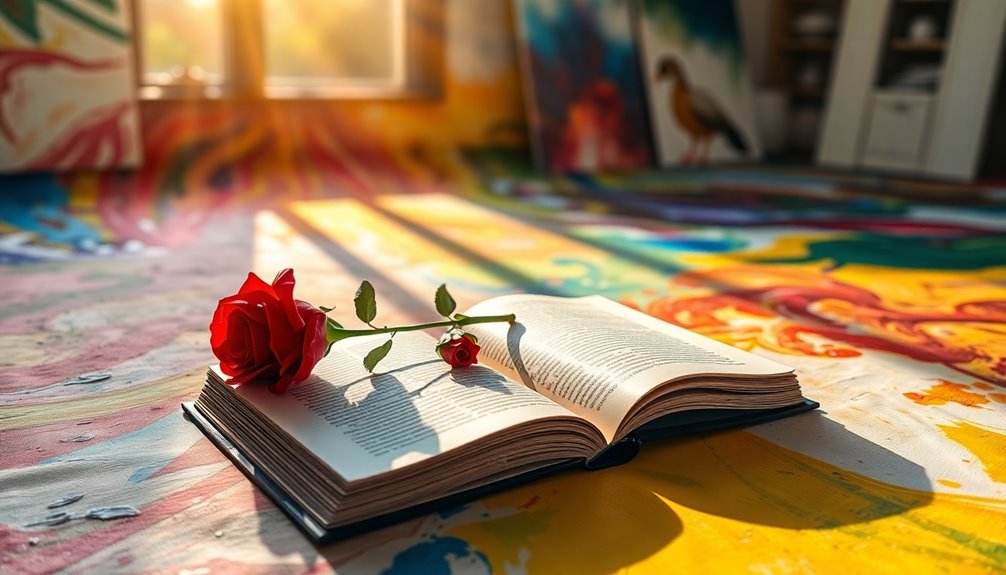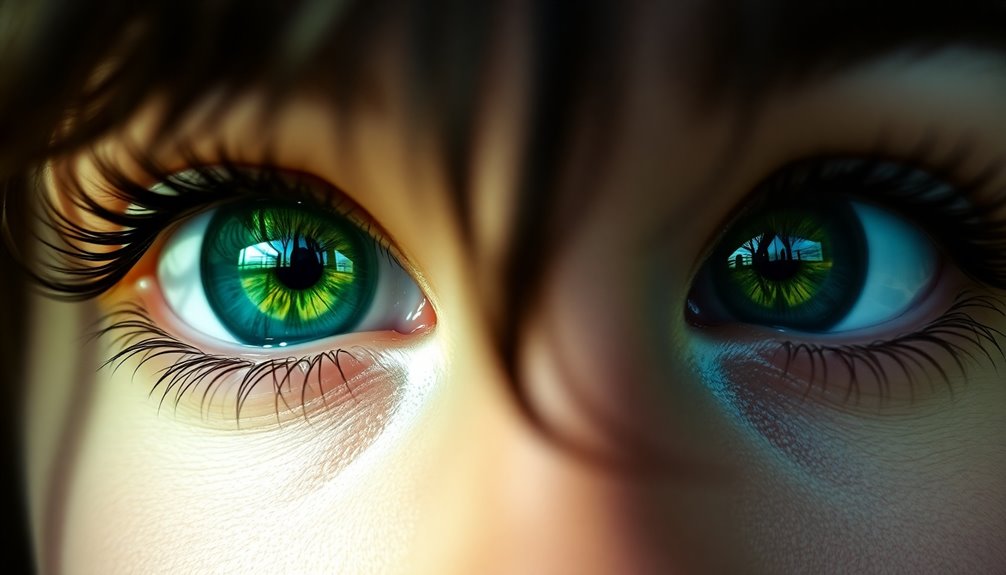The white owl is a potent symbol of wisdom and protection, serving as a guide during personal transformations. When you spot a white owl, it often signifies intuitive insights and spiritual awakening. Their cultural interpretations vary, often linking them to insight in Greek mythology or spiritual messages in Native American traditions. They encourage adaptability, inviting you to embrace change with open arms. Whether in dreams or folklore, they're seen as guardians of knowledge. If you're curious about the deeper meanings and connections of the white owl, there's much more to uncover about this mystical creature and its significance.
Key Takeaways
- White owls symbolize personal transformation, offering intuitive guidance and clarity during significant life changes.
- In various cultures, they represent wisdom, serving as spiritual messengers and omens of good fortune.
- Their pristine feathers signify spiritual purity and renewal, encouraging adaptability and trust in the transformation process.
- White owls inspire introspection, inviting individuals to confront fears and embrace new beginnings with an open heart.
- While associated with wisdom and protection, some beliefs link them to death, urging caution in interpreting their appearances.
Spiritual Significance of White Owls
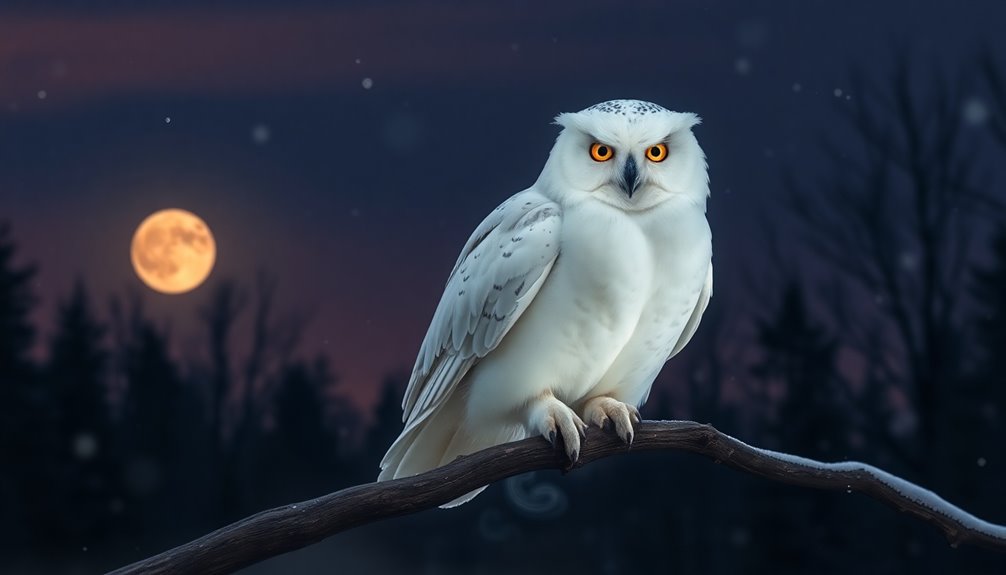
Recognizing the spiritual significance of white owls can deepen your understanding of personal changes and intuitive guidance. When a white owl appears in your life, it often symbolizes a powerful message from the universe.
These majestic creatures embody the spiritual meaning of owls, representing inner wisdom and clarity during times of change. Their pristine feathers reflect purity and spiritual renewal, guiding you from darkness into light.
As you commence on your journey of spiritual growth, the presence of a white owl can signal the start of significant changes. It encourages you to pay close attention to your surroundings and trust your intuition.
This connection to spirit guides offers profound wisdom, enhancing your psychic abilities and nurturing your spiritual awakening.
In many cultures, white owls are seen as messengers, bringing good fortune and protection. They remind you that you're not alone in your struggles and that your inner wisdom can lead the way.
Embrace the teachings of the white owl, and let its energy inspire you to navigate life's changes with grace and strength. Trust in the guidance it provides; your spiritual journey is unfolding beautifully.
Cultural Interpretations of White Owls
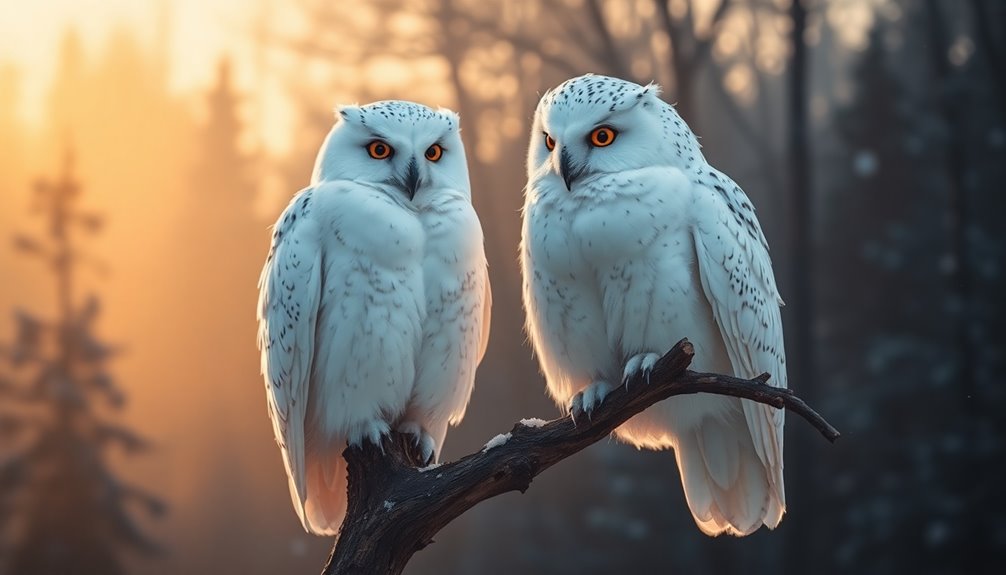
When you explore the cultural interpretations of white owls, you'll find fascinating mythological associations across the globe.
From Greek wisdom to Native American spirituality, each culture weaves its own unique narrative around these majestic birds.
Understanding these variations helps you appreciate how white owls symbolize different meanings in folklore and superstition.
Mythological Associations Worldwide
White owls hold rich mythological significance across various cultures, often embodying wisdom, protection, and change.
In Greek mythology, the White Owl is closely associated with Athena, the goddess of wisdom, symbolizing protection and knowledge during battles. This connection emphasizes the spiritual significance of the owl as a guardian and guide.
In Native American traditions, white owls are viewed as spiritual messengers, embodying the energy of ancestors and offering guidance during life changes. They're often seen as omens, providing insight into one's path.
Japanese folklore portrays white owls as symbols of good luck and protection, believed to attract positive energy while banishing negativity from one's life.
Conversely, in Mexican folklore, the "lechuza," or white owl, is depicted as a shape-shifting witch, showcasing both mystical and ominous qualities.
Celtic traditions associate white owls with the afterlife, considering them mysterious beings that guide individuals through the cycles of life and death.
Each of these interpretations highlights the profound symbolism of the White Owl, as it represents wisdom, protection, and spiritual insight across various mythologies worldwide.
Folklore and Superstitions
Throughout various cultures, the folklore and superstitions surrounding white owls illustrate their complex roles in human belief systems. The White Owl is often seen as a powerful symbol of wisdom and protection. In Greek mythology, you'll find white owls associated with Athena, representing knowledge and offering protection in battle.
In contrast, Native American cultures view these mystical birds as omens of death, acting as guides during your spiritual journey. Meanwhile, in Mexico, the white owl is believed to be a shape-shifting witch called "lechuza," embodying both mystical and protective qualities.
Japanese culture flips the script, viewing white owls as symbols of good luck and prosperity, believed to shield against negativity.
Here's a quick overview of these cultural interpretations:
| Culture | Belief/Interpretation |
|---|---|
| Greek | Symbol of wisdom and protection (Athena) |
| Native American | Omens of death, guides for spirits |
| Mexican | Shape-shifting witches ("lechuza"), protective |
| Japanese | Symbols of good luck, protectors against negativity |
These interpretations highlight the diverse spiritual meaning of the White Owl across different cultures.
Cultural Symbolism Variations
Exploring the cultural symbolism of white owls reveals a fascinating tapestry of interpretations that span the globe. In Native American cultures, you might find white owls revered as spiritual messengers, often linked to death and the connection between the physical and spiritual domains.
On the other hand, Greek mythology celebrates white owls as symbols of wisdom, closely associated with the goddess Athena, embodying protection and the pursuit of knowledge in life's battles.
In Japanese folklore, you'll see white owls regarded as bringers of good luck, serving as protectors against negativity and misfortune.
Meanwhile, Celtic traditions associate these mystical birds with the afterlife, representing the profound mysteries of death and rebirth.
In Mexican folklore, the white owl, or lechuza, takes on a dual role as a shape-shifting witch, symbolizing both supernatural power and cautionary themes about the unknown.
Each cultural interpretation enriches the symbolic landscape of white owls, highlighting their roles as harbingers of wisdom, protection, and the intricate connections between life, death, and the spiritual sphere.
Transformative Power of the White Owl
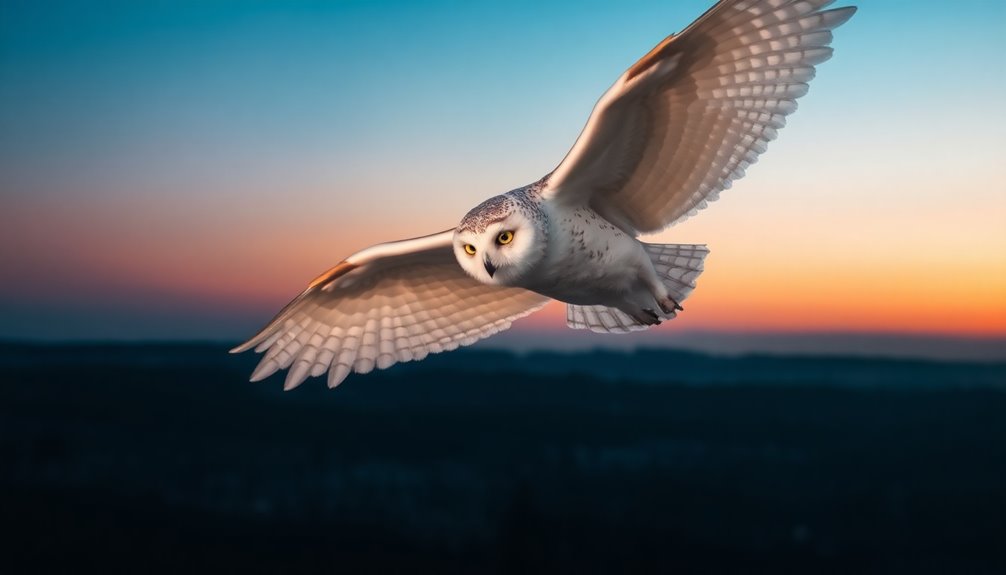
When you encounter a white owl, it's a powerful reminder of the spiritual transformations awaiting you.
This majestic creature guides you through change, encouraging you to embrace new beginnings with an open heart.
Trust in its presence, as it enhances your intuition and supports your journey toward personal growth.
Spiritual Transformation Insights
As you encounter the white owl, you may find yourself on the brink of profound spiritual transformation. This powerful symbol often appears during significant life changes, guiding you toward spiritual awakening and personal growth. The white owl serves as a reminder of the wisdom held within you, urging you to trust your intuition as you navigate through times of uncertainty.
Sighting a white owl can signal a spiritual message from the universe, indicating it's time for introspection. Embracing this moment allows you to acknowledge the cyclical nature of existence, where life and death intertwine. The symbolism of the white owl encourages you to accept both endings and new beginnings with an open heart and mind.
During periods of change, the white owl offers protection, reminding you that transformation is an essential aspect of your journey. By paying attention to your surroundings and the messages you receive, you can harness the transformative power of the white owl.
This mystical creature invites you to embrace your spiritual transformation, ultimately leading to greater awareness and understanding of your life's purpose.
Guidance During Change
The white owl stands as a powerful guide during times of alteration, offering clarity and direction when you need it most. As a spiritual messenger, the appearance of a white owl often heralds significant transformations in your life. These majestic creatures symbolize personal growth, urging you to embrace change rather than resist it.
When facing internal struggles, the sighting of a white owl invites deep introspection, prompting you to confront your fears and seek clarity. Their unique adaptability—represented by their ability to rotate their heads nearly 360 degrees—encourages you to trust the metamorphosis process, even when challenges arise.
In many cultures, white owls are seen as harbingers of good luck, reinforcing their role as guiding forces during pivotal moments. They remind you that change can lead to renewal and new beginnings, fostering resilience and strength.
As you navigate life's alterations, let the wisdom of the white owl illuminate your path, helping you find balance and direction. Embrace the guidance during change, and allow this mystical emblem to support your journey toward self-discovery and growth.
Embracing New Beginnings
Embracing new beginnings often involves letting go of the past and welcoming the possibilities that lie ahead. The White Owl serves as a powerful symbol of transformation, urging you to embrace significant life changes with an open heart.
When this majestic creature appears in your life, it's a sign that personal growth is on the horizon. The White Owl enhances your intuition, guiding you through uncertain times and helping you navigate your unique journey.
Its pristine white feathers represent spiritual purity and renewal, reminding you that each transformation can lead to a rebirth of the spirit and deeper self-awareness.
As you encounter this symbol, consider it a gentle nudge to engage in introspection. This reflective process allows you to release old patterns and truly welcome new opportunities.
The White Owl's presence offers protection, encouraging you to trust in your inner wisdom as you step into uncharted territory. Embracing curiosity can significantly enhance your problem-solving abilities, allowing you to approach new beginnings with an open and innovative mindset.
White Owl in Myths and Folklore
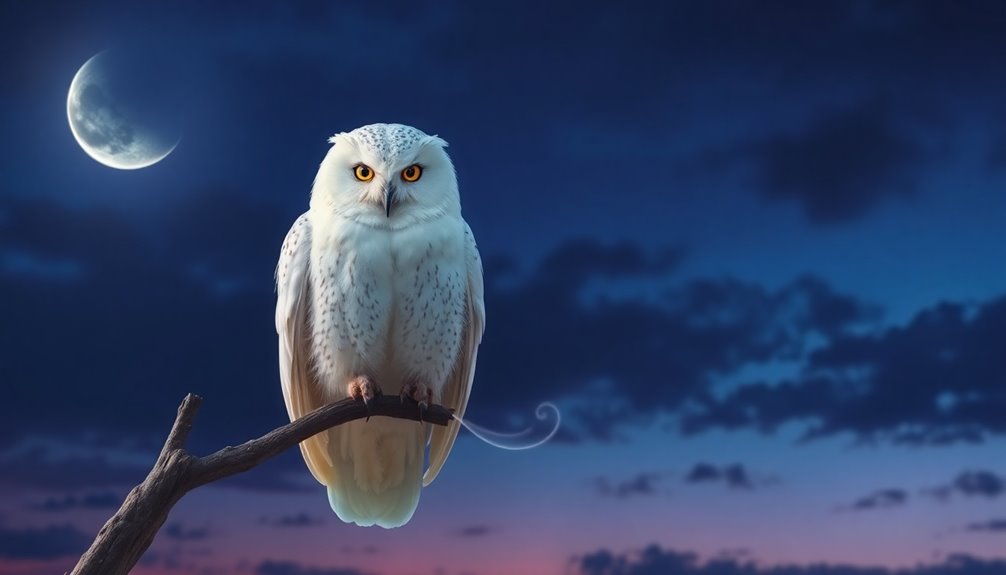
Throughout various cultures, white owls have captured the imagination of people, embodying a rich tapestry of meanings in myths and folklore. You'll find that these majestic creatures symbolize wisdom and protection across different traditions, each adding layers to their significance.
- In Greek mythology, white owls are sacred to Athena, the goddess of wisdom, representing strategic insight in battle.
- Native American cultures view white owls as spiritual messengers, often seen as omens of change that connect you to ancestors and the afterlife.
- In Mexican folklore, white owls, or lechuza, are shape-shifting witches illustrating their dual nature as protectors and cautionary figures.
- Japanese culture regards white owls as symbols of good fortune, believed to ward off negative energies while safeguarding ancestral ties.
Celtic traditions link white owls to the mystery of the afterlife, serving as guides through life's transformations.
Whether seen as protectors or symbols of wisdom, these enchanting birds invite you to explore the deeper meanings woven into the fabric of human belief.
Messages From White Owls
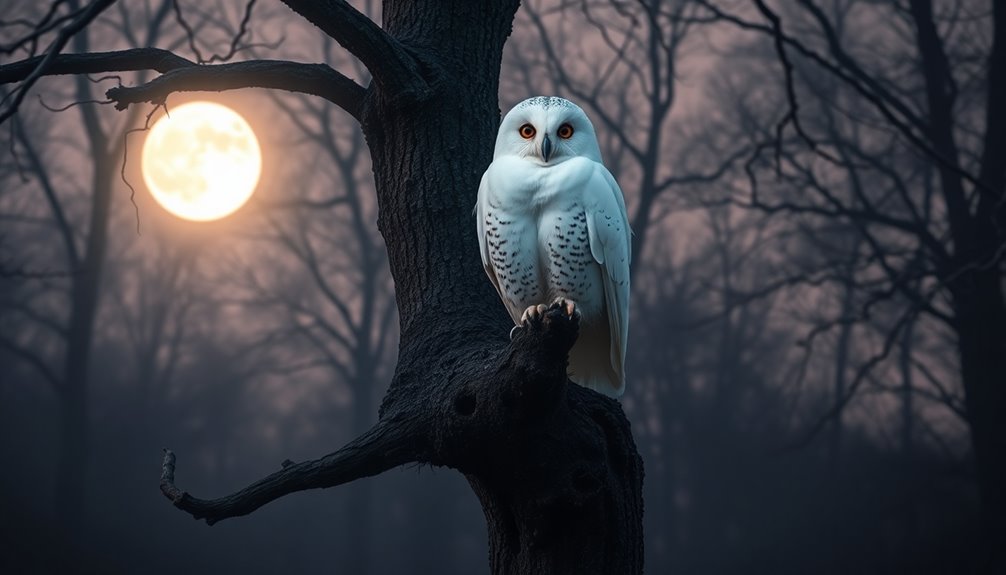
White owls are more than just symbols in myths; they act as spiritual messengers, delivering meaningful insights during pivotal moments in your life. When you encounter white owls, it's often a signal from the universe urging you to engage in introspection. These moments prompt you to examine your life circumstances closely and recognize hidden truths that may be influencing your path.
The presence of a white owl can herald imminent transformation, encouraging you to embrace new beginnings and foster personal growth. You might find that their appearances coincide with significant changes, serving as guidance and protection during this period. Trusting your intuition becomes essential, as these wise creatures help you navigate through uncertainty.
Repeated sightings of white owls in your daily life or dreams indicate important spiritual messages requiring your attention. They invite you to tap into your inner wisdom and reflect on your journey. By paying heed to their presence, you can uncover deeper insights that lead to profound transformation and align you with your true purpose.
Embrace these mystical encounters, as they guide you toward a more enlightened path.
White Owls in Dreams
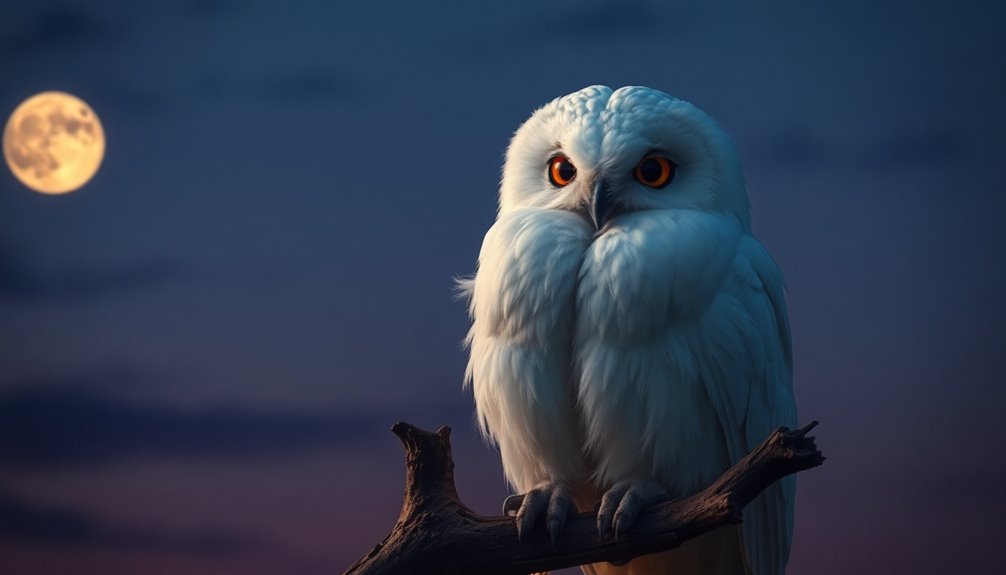
When you dream of a white owl, it often signals a quest for knowledge and a deeper understanding of your current life situation.
These dreams can indicate that you're seeking clarity amidst confusion, urging you to explore your emotional state and intuition. White owls serve as powerful symbols of spiritual guidance, revealing important messages from your subconscious.
Consider these deeper meanings when interpreting your white owl dreams:
- Wisdom and Intuition: The presence of a white owl suggests a call to trust your instincts and inner wisdom.
- Transformation: Flying with or being watched by a white owl can signify personal growth and transformation in your life.
- Messages from the Spiritual Dimension: Recurring dreams may indicate that you need to pay closer attention to spiritual messages related to your life's path.
- Protection: A white owl in your dreams can act as a guardian, providing comfort during times of change.
White Owl as a Spirit Animal
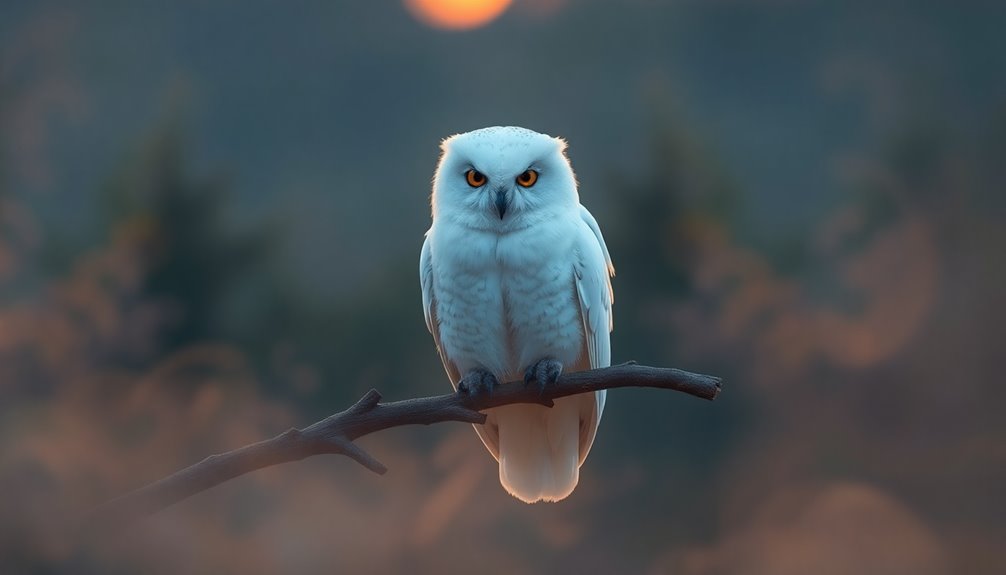
As you explore the significance of the white owl as a spirit animal, you'll discover it embodies profound wisdom and intuition, guiding you through life's complexities.
This powerful spirit animal encourages you to look beyond surface illusions and trust your inner wisdom. When the white owl appears in your life, it often signifies a significant change or shift, urging you to remain open to new opportunities and experiences.
Resonating with the white owl can lead to personal transformation, as it prompts you to engage in deep introspection and reflection.
Embracing this spirit animal can enhance your connection to spiritual dimensions and spark heightened psychic abilities, making it easier to navigate personal challenges.
In times of uncertainty, the white owl serves as a protector, helping you find clarity amid confusion.
By tapping into the guidance it offers, you can harness your intuition to make informed decisions and align with your true path.
Ultimately, the white owl as a spirit animal empowers you to embrace your journey with confidence, ensuring you remain grounded while exploring the depths of your soul.
Symbolism in Art and Literature
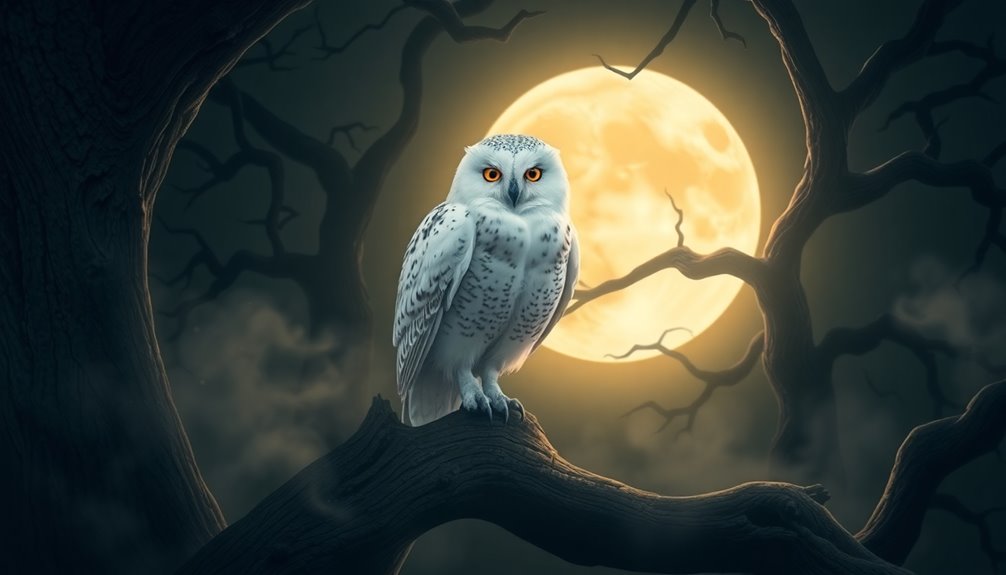
Owls, particularly the white variety, have captivated artists and writers for centuries, embodying wisdom and mystery. In various forms of art and literature, white owls symbolize not just beauty, but also serve as powerful representations of spiritual insight and protection. They often guide protagonists on transformative journeys, enriching narratives with their deep symbolism.
Here are some key themes regarding white owls in art and literature:
- Wisdom: Associated with the goddess Athena in Ancient Greek mythology, white owls represent knowledge and insight.
- Spiritual Significance: In Native American folklore, they act as messengers from the spirit world, reinforcing their connection to the mystical.
- Transformation: White owls symbolize personal growth and change, reflecting characters' journeys toward self-discovery.
- Protection: They often appear as guardians, offering safety and guidance during challenging times.
Through their striking plumage and piercing eyes, white owls evoke an ethereal beauty that enhances their role as symbols of wisdom.
Whether in mythology, literature, or art, their presence invites you to explore deeper meanings of your own spiritual journey.
Superstitions Surrounding White Owls

The haunting call of a white owl can send shivers down your spine, stirring a mix of fascination and fear. Superstitions surrounding white owls vary widely, revealing their dual nature as both omens of good luck and harbingers of caution. In many cultures, you might hear that these mystical creatures bring spiritual guidance and signify impending fortune. Their presence often suggests positive transformation, inviting you to embrace change.
However, tread carefully. Some Native American traditions associate white owls with death, implying that their appearance may foreshadow significant loss or shifts in life. In Mexican folklore, white owls are linked to shape-shifting witches, warning against malevolent forces and urging you to exercise caution.
The ancient Greeks viewed white owls as symbols of knowledge and protection, tied to Athena, the goddess of wisdom. This connection reinforces their protective qualities in some contexts. Additionally, the bond between a father and daughter can also be seen as a source of guidance and support, paralleling the protective nature attributed to white owls.
Yet, the superstitions also caution against venturing out at night, as the eerie calls of white owls might signal danger or misfortune. Balancing these beliefs may help you navigate the intriguing, complex world of white owl symbolism.
Frequently Asked Questions
What Does a White Owl Mean Spiritually?
When you encounter a white owl, it signals change and transformation in your life. This spiritual messenger encourages you to trust your intuition and embrace self-reflection, guiding you toward renewal and deeper spiritual awareness.
What Does the Wisdom Owl Symbolize?
The wisdom owl symbolizes knowledge, insight, and intuition. When you connect with this emblem, it encourages you to trust your instincts, seek clarity, and embrace personal growth, guiding you through life's complexities and transformations.
What Does a White Owl Symbolize in the Bible?
In the Bible, while white owls aren't specifically mentioned, they symbolize spiritual vigilance and the need for discernment. They prompt you to seek wisdom and guidance amidst desolation, reflecting your journey through darkness and uncertainty.
What Does an Owl Symbolize Spiritually?
When you think of an owl, imagine the wisest sage, whispering secrets of the universe. Spiritually, owls symbolize intuition, transformation, and guidance, urging you to embrace change and seek deeper understanding during life's pivotal moments.
Conclusion
In the tapestry of life, the white owl weaves threads of wisdom and protection, guiding you through the shadows. Whether it whispers ancient secrets in your dreams or stands sentinel in folklore, its presence beckons you to embrace transformation. As you journey onward, remember the white owl's watchful gaze—an emblem of clarity and insight. Let its spirit inspire you, igniting a spark of wonder as you navigate the mysteries that lie ahead.





